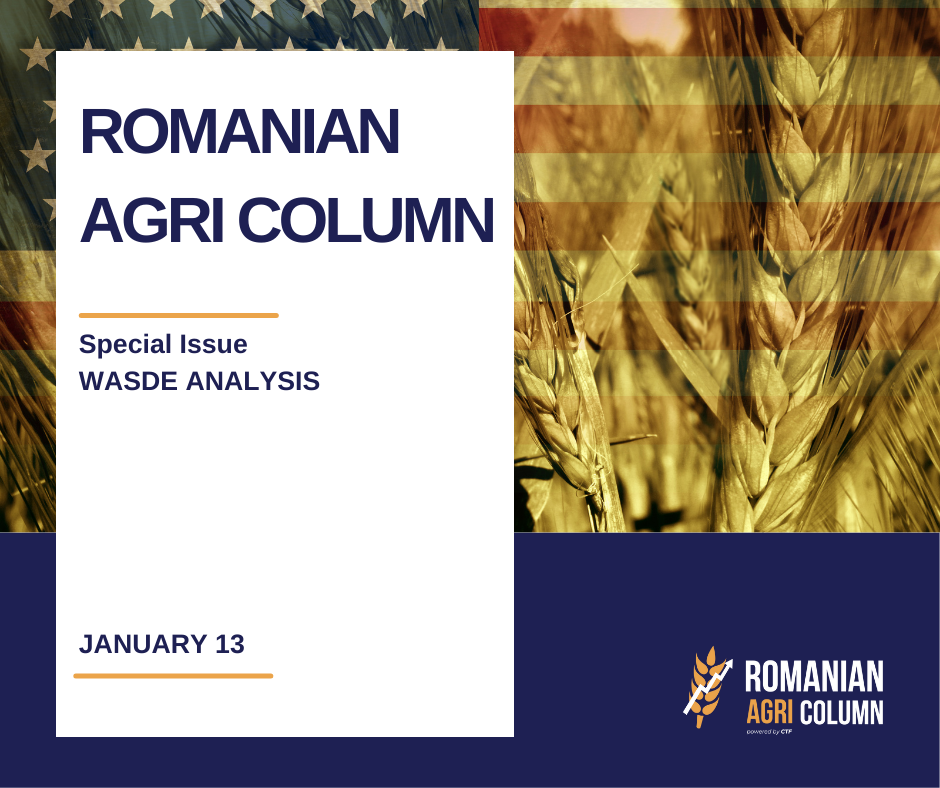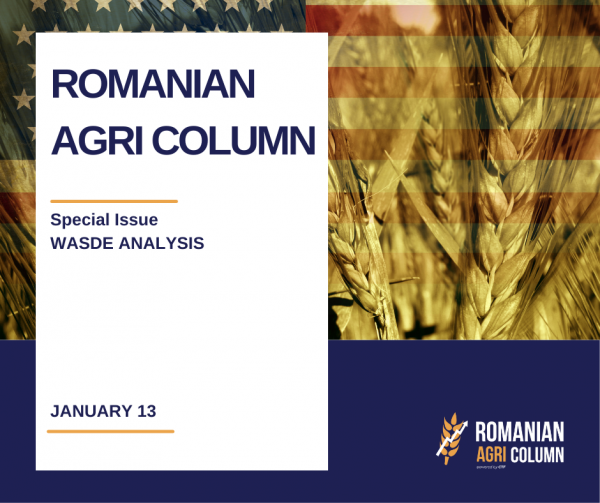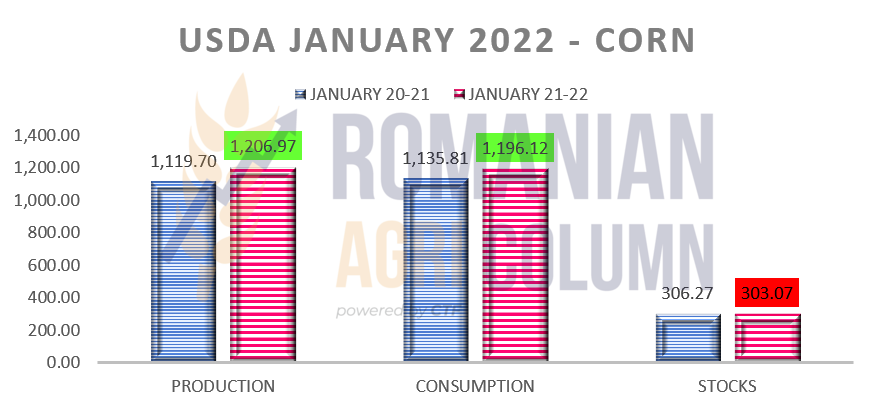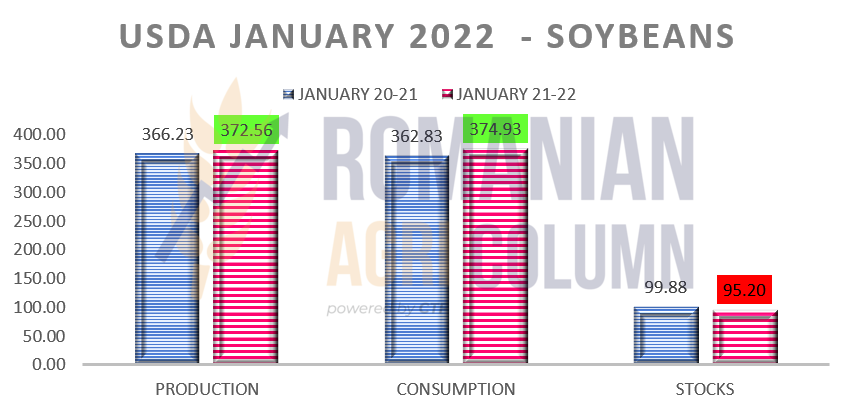
Today’s special market report is dedicated to WASDE (World Agricultural Supply and Demand Estimates), a market report of the United States Department of Agriculture. Below you can find information on global production, consumption and stocks for the following crops:
PRODUCTION: WASDE increased global wheat production by adding a surplus crop to Argentina at 21 million tons. The EU figure was also raised by 0.2 million tons, so we have an additional 0.7 million tons added to the global production of the agricultural year 2021-2022, to the level of 778.6 million tons.
CONSUMPTION: WASDE generated a declining overall consumption ratio of 1.88 million tons to 787.47 million tons. This is due to lower usage in the US, EU and Ukraine. The reduction in consumption is directly correlated with the high price of wheat and thus the demand becomes lower. In the same context, global wheat trade is down by 1.1 million tons to 204.4 million tons, which could cause problems for exporters in wheat-producing countries: the Black Sea basin, the EU, USA, Argentina and Australia.
STOCKS: WASDE has naturally increased global wheat stocks due to lower utilization surplus as well as the decline in global trade forecasts. Thus, wheat stocks increase by 1.77 million tons, to the level of 279.95 million tons.
WASDE JANUARY 2022
PRODUCTION – CONSUMPTION – STOCKS
0.7 | -1.88 | 1.77 = BEARISH MARKET
ANALYSIS
- Wheat feels the pressure of the update at the production level.
- Wheat feels the pressure of very high prices.
- Wheat, by reducing consumption, increases stocks in origin and lowers the level of global transactions.
PRODUCTION: WASDE generated a declining global production, reducing the level of maize by 1.77 million tons. Thus, we have a production figure reduced to the level of 1,206.96 million tons compared to December 2021, when the estimate was positioned at 1,208.73 million tons. The decrease in corn production comes from Brazil, where Safra was reduced by 3 million tons. Argentina is also down 0.5 million tons, Mexico down 0.4 million tons and the EU down 0.4 million tons. Partial compensation comes from Ukraine, which received a production surplus of 2 million, up to a level of 40 million tons.
CONSUMPTION: WASDE has increased consumption globally, but not significantly, so we have a higher level of 0.24 million tons compared to December 2021, to the level of 1,196.12 million tons. This results in higher ethanol consumption. Consumption also remains high due to competition between origins. And we are talking here about the Black Sea, the EU and the two Americas, the South and the North.
STOCKS: WASDE generates a lower level of stocks as a natural consequence of the reduction in global production and is expressed in figures at a minus of 2.47 million tons, down to 303.07 million tons. Problems in Brazil will soon reverberate in Argentina due to the heat wave that has taken over the area, compounded by persistent drought, so we will see in February a scenario somewhat similar to that of January 2022.
WASDE JANUARY 2022
PRODUCTION – CONSUMPTION – STOCKS
-1.77 | 0.24 | -2,47 = BEARISH WHEAT MARKET WHICH WILL PULL CORN DOWN TOO
ANALYSIS
- Drought is causing problems in South America. Brazil’s 3 million-ton bite is a start.
- Argentina follows with a similar scenario.
- Logistics creates the premises for competition between origins.
- China reports a 3 million-tone reduction in corn imports, indicating a neutral market potential (let’s not get fooled, China buys when it is cheap, so we may see a reversal of the trend when corn falls further)
PRODUCTION: WASDE effectively reduces overall soybean production by more than 9 million tons, specifically by 9.22 million tons, to 372.56 million tons. This massive reduction has its origins in South America, where Brazil is reduced by 5 million tons and Argentina by 3 million tons. In addition, we add Paraguay, which is reduced by 1.5 million tons in production. These reductions are the result of La Nina’s second consecutive year. Its effects are devastating for South American countries due to lack of rainfall and excessive heat. The only plus is the US, with a positive revision of 0.3 million tons, but this does not offset the massive production cuts in South America.
CONSUMPTION: WASDE decreases global soybean consumption by 2.1 million tons to 374.93 million tons. This is, in fact, a side effect of declining production in South America. The decline in consumption comes from Argentina’s crush capacity, which is affected by declining production, knowing that Argentina processes soybeans to produce the soybean meal it exports.
STOCKS: WASDE reduces global stocks by 6.8 million tons to 95.2 million tons from 102 million tons in December 2021. The decline in stocks is due to reduced production by 9.22 million tons and is also a side effect. If we subtract the figure of the reduction of stocks from the figure with which the production decreased, we find a figure very close to the one that indicates the decrease of consumption.
WASDE JANUARY 2022
PRODUCTION – CONSUMPTION – STOCKS
-9.22 | -2.10 | -6.80 = GROWING MARKET (BULLISH)
ANALYSIS
- La Nina wreaks havoc on the South American soybean crop.
- An aggregate deficit of over 9 million tons pushes soybeans to new price stages.
- CBOT reacted accordingly after the report was published.
- The story is not over yet. February will bring new discounts.
















